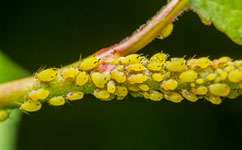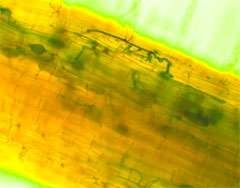Aphid infestation.
Plants use underground fungal networks to warn their neighbours of aphid attack, UK scientists have discovered.
The research, published today in Ecology Letters, changes our understanding of how things interact with one another.
If crops can be managed in a way that exploits the natural communication channel, it could also provide a new weapon in the battle against insect pests.
'Our understanding of ecological systems has not considered the fact that plants are interconnected in this way,' says Dr David Johnson of the University of Aberdeen, who led the study. 'It could have major implications for our understanding of how one organism affects another.'
The team grew bean plants in groups of five, allowing three in each group to grow underground networks of mycelia, thread-like fungi that grow from one set of roots to another. They kept two plants free of the fungal links.
They then infested one of the plants in each group with aphids, triggering the release of a suite of chemicals designed to repel aphids and attract wasps, one of the pest's predators.
Remarkably, plants which were not under attack themselves, but which were wired to the victim by the underground fungal network, also began to produce the defensive chemical's.
Unconnected plants didn't get the warning, and remained vulnerable to aphid attack.
Previous research has shown that plants can communicate chemically through the air, but the scientists covered the plants with bags to rule out above-ground signalling.
'We knew that plants produce volatile chemicals when attacked, and we knew they communicate danger to each other above ground,' says Johnson. 'Now we know that they communicate danger through these underground fungal networks as well.'
Fungal infection.
'Connected plants that weren't infested by the aphids behaved as though they were. We don't quite know the mechanism of communication, but it's likely to be a chemical signal.'
The mycelium fungus, a white, stringy material that you might find on a rotting apple, forms a give and take relationship with plants known as symbiosis. In exchange for the carbon it needs, the fungus spreads through the soil allowing the plant to draw in nutrients from a wider area.
The roots of virtually all groups of plants, including important food crops such as wheat, rice, maize and barley, are colonised by symbiotic fungi.
According to another of the study's authors, Professor John Pickett of Rothamsted Research, the underground communication channel could open the door for a new, natural and sustainable way of tackling pests and diseases.
'In a field of plants that have some inducible resistance to aphids, we could use a plant that's susceptible to aphid attack to 'switch on' the defence mechanism through the natural underground connection,' he says.
'Aphids affect all higher-latitude agricultural regions, including the UK, the EU, North America, and North East Asia and there's the potential to deal with other pests and diseases, in other regions, in a similar way.'
More information: Babikova, Z. et al. Underground signals carried through common mycelial networks warn neighbouring plants of aphid attack, Ecology Letters, 2013. DOI: 10.1111/ele.12115
Journal information: Ecology Letters
Provided by PlanetEarth Online
This story is republished courtesy of Planet Earth online, a free, companion website to the award-winning magazine Planet Earth published and funded by the Natural Environment Research Council (NERC).
























